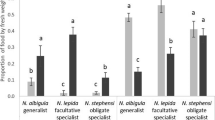Abstract
One theory in plant antiherbivore defense predicts that slow growing late succession plants like white spruce (Picea glauca) make large investments in antiherbivore defenses. Juvenile stages of white spruce in the Yukon, Canada, are rarely browsed by snowshoe hares (Lepus americanus), an abundant herbivore, but mature spruce is a highly preferred food. The hexane-soluble fractions of the methanol extracts from juvenile and mature white spruce contain camphor and bomyl acetate. There is four times as much camphor in juvenile spruce as in mature spruce from GC analysis. Plant extracts were added to rabbit chow. Pairs of extracts were offered to hares in choice tests. These tests demonstrated that camphor in the juvenile spruce extracts deterred feeding. Bornyl acetate did not have a clear antifeeding effect.
Similar content being viewed by others
References
Bryant, J.P. 1981. Phytochemical deterrence of snowshoe hare browsing by adventitious shoots of four Alaskan trees.Science 313:889–890.
Bryant, J.P., andKuropat, P.J. 1980. Selection of winter forage by subarctic browsing vertebrates: The role of plant chemistry.Annu. Rev. Ecol. Syst. 11:261–285.
Bryant, J.P., Chapin, F.S., andKlein, D.R. 1983a. Carbon/nutrient balance of boreal woody plants in relation to vertebrate herbivory.Oikos 40:357–368.
Bryant, J.P., Wieland, G.D., Reichardt, P.B., Lewis, V.E., andMcCarthy, M.C. 1983b. Pinosylvin methyl ether deters snowshoe hare feeding on green alder.Science 222:1023–1025.
Bryant, J.P., Wieland, G.D., Clausen, T., andKuropat, P. 1985. Interactions of snowshoe hares and feltleaf willow in Alaska.Ecology 66:1564–1573.
Clausen, T.P., Reichardt, P.B., andBryant, J.P. 1986. Pinosylvin and pinosylvin methyl ether as feeding deterrents in green alder.J. Chem. Ecol. 12:2117–2131.
Coley, P.D., Bryant, J.P., andChapin, F.S. 1985. Resource availability and plant antiherbivore defense.Science 230:895–899.
Dreimanis, A. 1968. Extinction of mastodons in eastern North America: Testing a new climaticenvironmental hypothesis.Ohio J. Sci. 68:257–272.
Palo, R.T. 1984. Distribution of birch (Betula spp.), willow (Salix spp.), and poplar (Populus spp.) secondary metabolites and their potential roles as chemical defense against herbivores.J. Chem. Ecol. 10:499–520.
Palo, R.T., Sunnerheim, K., andTheander, O. 1985. Seasonal variation of phenols, crade protein and cell wall content of birch (Betula pendula Roth.) in relation to ruminant in vitro digestibility.Oecologia 65:314–318.
Reichardt, P.B., Bryant, J.P., Clausen, T.P., andWieland, G.D. 1984. Defense of winter-dormant Alaska paper birch against snowshoe hares.Oecologia 65:58–69.
Reichardt, P.B., Green, T.P., andChang, S. 1987. 3-O-Malonylbetulafolientriol oxide I fromBetula nana subsp.exilis. Phytochemistry 26:855–856.
Siegel, S. 1956. Nonparametric Statistics. McGraw-Hill, New York.
Sinclair, A.R.E., andSmith, J.N.M. 1984. Do plant secondary compounds determine feeding preferences of snowshoe hares?Oecologia 61:402–410.
Still, W.C., Kahn, M., andMitra, A. 1978. Rapid chromatographic technique for preparative separations with moderate resolution.J. Org. Chem. 43:2923–2925.
Tahvanainen, J., Helle, E., Julkenen-Tiitto, R., andLavola, A. 1985. Phenolic compounds of willow bark as deterrents against feeding by mountain hare.Oecologia 65:319–323.
Author information
Authors and Affiliations
Additional information
On leave from the Department of Chemistry, University of South Pacific, Fiji.
Rights and permissions
About this article
Cite this article
Sinclair, A.R.E., Jogia, M.K. & Andersen, R.J. Camphor from juvenile white spruce as an antifeedant for snowshoe hares. J Chem Ecol 14, 1505–1514 (1988). https://doi.org/10.1007/BF01012422
Received:
Accepted:
Issue Date:
DOI: https://doi.org/10.1007/BF01012422




